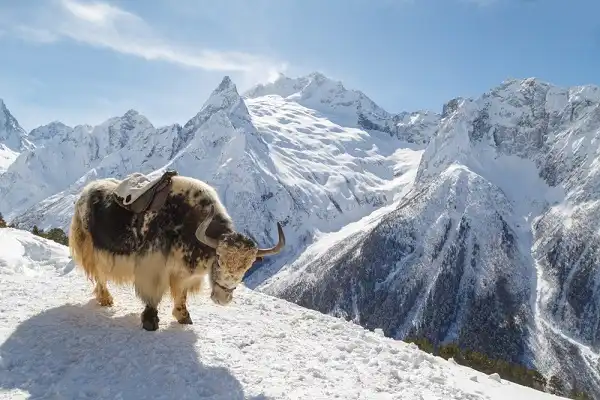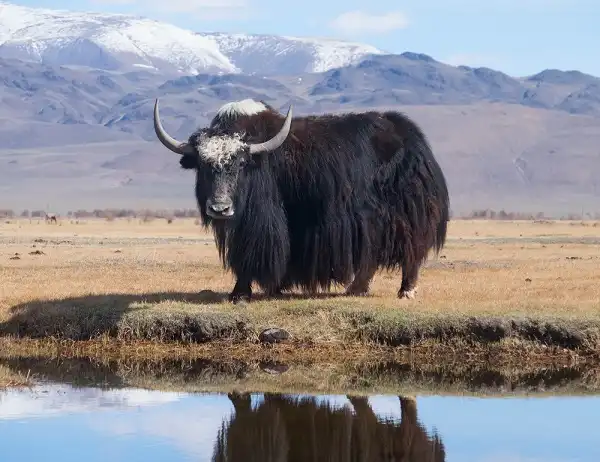The yak is a long-haired bovid native to Tibet, the Himalayas, and Central Asia. Yaks are considered sacred in some cultures, and their meat and dairy products are widely consumed. In this blog post, we’ll explore the history and cultural significance of yaks, as well as their importance in Tibetan cuisine.

Yak Description
Yaks are large, shaggy animals that resemble a cross between oxen and bison. They have long, thick coats of fur to protect them from their cold mountain environment. Yaks come in many colors, ranging from black or brown to white or grey.
Yak Habitat
Yaks are well-adapted to their high-altitude mountain environments and have developed several physical characteristics that enable them to thrive in these harsh locations. For example, their thick coats of long fur help keep them warm in the cold temperatures and winds of these high altitudes. In addition to their fur, yaks have larger lungs and hearts that allow them to take in more oxygen, which is essential at the high altitudes they inhabit. Yaks are also able to walk on slippery surfaces due to their wide hooves, which provide extra grip and stability.
Yak Diet
Yaks are herbivores that primarily eat grass and other vegetation. They also consume lichens, mosses, shrubs, and bark during the winter months when their food supply is low. Yak’s milk can be used to make butter, cheese, yogurt and other dairy products. It is especially rich in omega-3 fatty acids and conjugated linoleic acid (CLA), both of which are important for good health.

Yak Size
Yak size is determined by sex, with bulls (male yaks) usually weighing more than cows (female yaks). On average, male yaks can weigh up to 2,200 pounds and reach 6 feet tall at the shoulders, whereas female yaks typically weigh less.
At certain times of the year, such as during mating season or when they are pregnant, female yaks may be able to weigh more due to increased muscle mass and water weight.
Both male and female yaks have horns that grow up to 3 feet long with a twist at the tips. Male yak horns tend to be wider near the base than those of females.
Yak size is important for many practical reasons. For example, larger size provides more protection from predators like wolves and snow leopards. The thicker fur of large yaks also helps them stay warm in cold mountain environments where they live in high altitudes. In addition, larger size makes it easier for yak farmers to transport their animals over long distances without having to rest too often; this is especially useful in mountainous areas where there are few roads.
Furthermore, larger animals generally produce more milk and wool than smaller ones, making them valuable assets for yak farmers who rely on these products for income. As such, yak farmers typically strive to breed the largest animals possible in order to maximize profits.
Yak Lifespan
Yaks can live as long as 30 years in the wild. They are seasonally migratory animals and can cover up to 500 miles a year searching for food and water. In captivity, yaks can still live a long life and typically reach an age of 15-20 years.
Yak calves generally start reproducing at the age of two or three and can have up to four offspring in their lifetime. Yak cows tend to give birth every two or three years.
The lifespan of a yak will vary depending on environmental factors such as weather conditions, food availability, and predation pressure from other animals like wolves and snow leopards. In addition, the health status of a yak may also affect its lifespan; disease outbreaks, injuries, and poor nutrition can all reduce a yak’s life expectancy. Yak farmers must make sure that their animals are healthy and well taken care of in order to maximize their lifespan.
Yak Behavior
Yaks are social animals that live in herds of up to 50 individuals. They communicate with each other using body language, vocalizations, and scent marking. Yaks will also sometimes form alliances with other species such as goats and sheep.
Yaks are relatively peaceful animals and will usually only fight when provoked or over resources. Bulls may also show aggression towards other males during mating season in order to establish dominance.
Yaks tend to migrate seasonally in search of food, water, and shelter. During these migrations, yaks can travel up to 500 miles a year. They typically move along mountain ranges and prefer high altitudes due to the cooler temperatures found there. Yaks are also well adapted to cold climates; they have thick fur that helps insulate them against the elements. Furthermore, their large size allows them to store fat for energy during long migrations and lean times when food is scarce.

Yak Hunting
Yaks are hunted for their meat, fur, and horns. In some areas, yak hunting is still practiced as a part of traditional culture. However, in other areas, it has been banned due to conservation concerns.
Yak Cultural Significance
The yak has been an important part of Tibetan culture for centuries. It is considered a sacred animal that represents strength and fertility. Tibetans use yaks for transportation, herding, dairy products, meat, hides, and wool. Yak butter lamps are used in Buddhist ceremonies and the horns are incorporated into traditional musical instruments.
Yak Conservation
Yaks are not considered an endangered species, though their population has been in decline due to hunting and habitat destruction. Conservation efforts have been put in place to protect the yak, including bans on hunting and restrictions on grazing areas.

Conclusion
The yak is an important part of Tibetan culture and tradition. It provides sustenance in the form of milk, butter, cheese, meat, hides, and wool. Yak hunting has been banned in some areas due to conservation concerns but it continues to be practiced as a part of traditional culture in some places. The IUCN lists the yak as a species of the least concern due to its stable population. Yaks are seen as symbols of strength and perseverance and bring good luck according to Tibetan beliefs.
Frequently Asked Question


